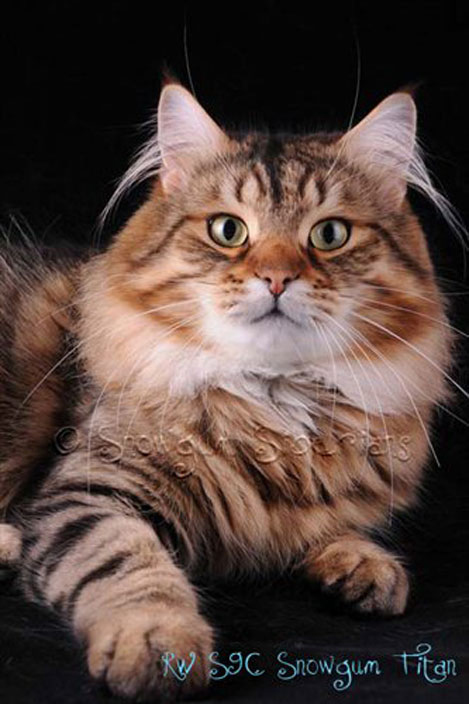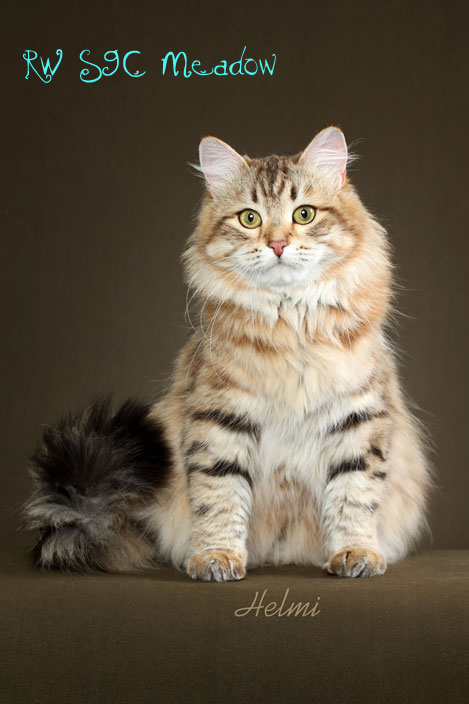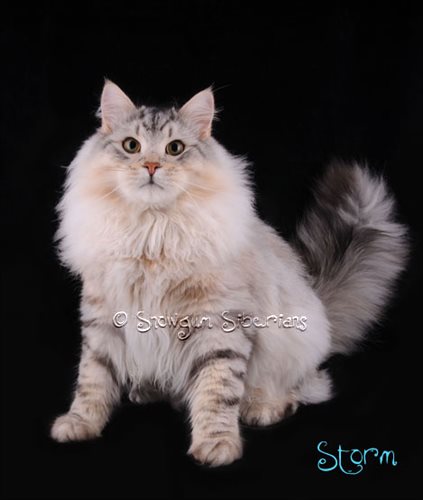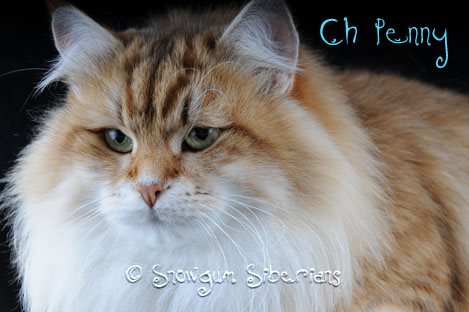The Siberian Cat & Neva Masquerdade Breed

The Siberian/Neva Masquerade Breed
When people ask me what breed of cat we have they often look perplexed when I say "Siberians and Neva Masquerades!" This is because the Siberian cat is still a relatively new breed in Australia, the first arriving here from the US in 2003. Neva Masquerades (colour point Siberians with blue eyes) have been a part of the Siberian breed from the very beginning- the first Siberian breed standard was based on a brown tabby and white (Siberian) Male and a Blue Tabby Point and white (Neva Masquerade) male. The blue-eyed Siberian have only been accepted in Australia for a few years despite being allowable world-wide since the beginning of the Siberian breed.
While the standard varies slightly between the cat registries, the Siberians and Neva Masquerades are fully accepted by TICA, FIFe, WCF, CFA,the GCCF and the ACF. In ACF and CFA Australia, colour point or blue-eyed Siberians are documented a "Neva Masquerades" where as blacks, golds, blues, silvers and red series are documented as "Siberians". Siberians and Nevas are allowed to interbreed fully as they are both essentially Siberian cats.
Appearance
The Siberian/Neva Masquerade cat is a large, hefty cat with males being somewhat larger than the females. They are slow growing, taking up to 5 years to reach their full size. They are semi-long haired with a triple coat including a dense soft undercoat, and an outercoat of thick, shiny "guard hairs" which gives the coat a waterproof quality. Their first full adult coat usually comes in the winter after their first birthday including a beautiful ruff around their head, making them look like little lions! They also have tufts of fur between their paw pads and brushes of fur coming out from their ears equipping them for snowy weather and beautiful "lynx tips" on their ears which helps to give them their wild look.
The cat registries' Siberian breed standards go into more detail about exactly how a Siberian cat should look. As we show our cats in Cats NSW (which is part of ACF) and previously in TICA these are the standards we aim for in our kittens. Click on the following links to see the standards:
- ACF Neva Masquerade Breed Standard
- ACF Siberian Breed Standard
- TICA Siberian Breed Standard
- NSW CFA Siberian Breed Standard
- WCF Siberian Breed Standard
- FIFe Siberian Breed Standard
The Siberian cat comes in a rainbow of colours including brown, red, blue, cream, gold, silver, smoke, tortie, white, and colour point. Here at Snowgum, our cats have the genes to produce black/brown, silver, golden, blue, black smoke and colourpoint kittens. Some will be with white (like Indiana and Astra) and others without. Most of our kittens will have a beautiful mackerel tabby (striped), classic tabby (blotched), spotted or shaded tabby pattern and beautiful green or gold and green eyes or blue eyes for the Nevas. We get the occasional beautiful and rare solid black or black smoke kitten. For details and images of cat colours please see our Siberian Cat Colours page.
Temperament
Siberian cats are often described as having a "dog-like" personality. They are loyal, affectionate, playful and want to be your best friend. Our cats greet us at the door when we come home, follow us from room to room wanting to hang out where ever we are and help with what ever we are doing! Meadow even plays fetch like a dog!
They are very intelligent cats and will quickly work out how to open doors and how to get their favourite toy from its hiding spot! They mix easily with other animals including dogs and because they are a gentle, loving cat they are also a great breed for families with small children. Our kids have grown up with our cats around them; my daughter's first word was her favourite cat's name, "Dasha".
Some Siberians are lap cats and will loving nothing better than snuggling on your lap, others are sightly more independent and prefer to sit next to you on the sofa rather than right on your lap. Either way, they love to interact with you and often will play with you for as long as you have the stamina! Many of them want to be involved with your every day activities and enjoy "helping" you with your chores or your reading or typing - a newspaper or keyboard is the best place for a Siberian to take a nap when you have some reading or writing to do!
Lifespan
A typical lifespan for a Siberian cat is between 10 and 12 years. Some Siberians have however, been known to live 18 years! Keep in mind that your kitten will be more likely to live a long live if it is fed a healthy raw diet, given good vet care, plenty of exercise and kept away from the dangers of the outdoors. A outdoor cat typically has a shorter lifespan however indoor-only cats can also succumb to disease due to inactivity and diet, lack of access to direct, unfiltered sunshine and lack of access to grass used to optimise digestion. It is a balancing act and access to exercise, good diet and sunshine should be considered prior to purchasing your pet.
When considering buying a kitten you should be prepared to give it a loving home for the next decade or so. Buying a kitten is not something to be done on a whim; it is a commitment for the lifetime of the animal and should only be done after much consideration. Sadly, all pets will pass away at some point and we cannot predict when this will be or what they will pass from. We therefore require you to understand and accept this risk and take out pet insurance in order to cover replacement cost and any potential veterinary or non-veterinary fees for any accident, injury, illness, loss by theft or straying or death.
Health
The Siberian cat is one of the 3 breeds of "forest" cats, and is one of the oldest "natural" breeds of cats, meaning they are not a human developed breed created by crossing various other breeds. As a result, they are a robust breed able to survive in harsh winters and with relatively few health problems.
In recent years the following testable genetic diseases have appeared in the breed: Polycystic Kidney Disease(PKD) and Erythrocyte Pyruvate Kinase Deficiency (PK Deficiency). Our cats are in the process of having their DNA tests updated to ensure they are negative for the genes responsible for these diseases.
Heart disease including HCM can occur in all breeds of cat and domestic (non-purebred) cat. Despite research on the topic, there has not been a gene identified for HCM or other heart disease in Siberians. DNA tests for heart disease exist for the Maine Coon and Ragdoll breeds however these tests are not valid for testing Siberians. Performing an echocardiogram (ultrasound) on Siberian cats, is the only way of truly testing for heart troubles. Ultrasounds are not infallible as they are a point in time test and do not show what could happen in the future, they can only show that at the time of ultrasound the heart is free from heart disease and structural defects. As such, many of our breeding cats have had an echocardiogram by a specialist in veterinary cardiology prior to their first breeding. We occasionally retest them around every 3 years or so (where practical between litters and only if cardiologists are available) to check they are still well. If a cat does have a negative scan they would immediately be removed from our breeding program. This testing cannot show if they will develop illness in the future and as such, we cannot make any guarantees around heart health and we require you to understand and accept this risk and purchase insurance for your kitten in order to cover for this or any other health issues if troubles are encountered in the future.
Like all living things, Siberian cats can become injured and develop/contract illnesses. Some illness and injuries can be prevented and we give you instructions on these prior to taking your kitten home, but others are unpredictable, even with the best tests that modern science can provide. As such, we require you to understand and accept this risk and take out insurance to cover yourself for this risk, prior to purchasing/taking home your kitten.
History
Siberian is the name given to Russia's native semi-longhaired cat. There is a lack of historical information about Siberian cats so many stories have developed over time to explain the breed's origin. Siberian cats were apparently first documented in the year 1000 though they were not a pedigreed breed at this stage, but rather were the mouse catchers in the streets and homes throughout Russia.
The Siberian cat was considered to be a large, solid cat with a waterproof coat and thick undercoat. Due to their appearance these cats could survive in the cold, severe climate. The cats were seen in a wide variety of colours.
The modern Siberian as we know it, is the result of the development of a written "breed standard" for the cat and of the hard work and time of many breeders and judges. In the late 1980's the first imported cat breeds started to appear in Russia and the first cat shows were held there. It was decided that a breed standard should be developed to distinguish these large, fluffy Russian cats from the other long haired cat breeds. The President of the Kotofei club, Olga Mironva developed the first Siberian breed description. A brown tabby and white Siberian stud Roman, born in 1987 was used as the basis for this first written standard. He appears in many pedigrees (including our Indiana's) and was one of the foundation cats for the breed. The WCF was the first international cat registry to accept the Siberian Cat, including the colour point Siberian, nicknamed the "Neva Masquerade". A blue tabby point with white stud called Mars born in 1988 was the founding colour point of the breed. Mars and Roman can be seen at the beginning of many Siberian pedigrees even today.
In 1988 judges from abroad began to visit Russian shows and this sparked an international interest in the Siberian cat. The first Siberians entered Australia quite a bit later in 2003 from the US. There are now quite a number of Siberian cat breeders in Australia and the number is increasing every year as more people meet and fall in love with the wonderful Siberian breed.
For a more detailed account of the history of the Siberian Cat Breed please follow this link to a history written by Dr. Irina Sadovnikova, WCF judge and Russian breeder of Siberian Cats: Siberian Cat History
Why choose a Siberian/ Neva Masquerade?
Siberians and Nevas are smart, loyal, agile, interactive, affectionate, playful and ever so entertaining! They are great with children and other pets, can be tolerated by many cat allergy sufferers and are real characters to live with. As well as being a fantastic pet I think you will also agree they are a gorgeous looking cat! They will quickly capture your heart and after adopting a Siberian you will wonder how you ever lived without one! If you adopted just one, I am sure that I will hear from you within 6 months to request a second- Siberian cats are addictive!



